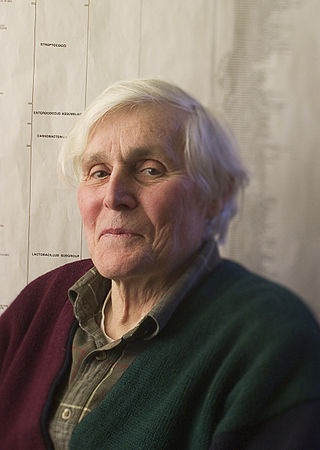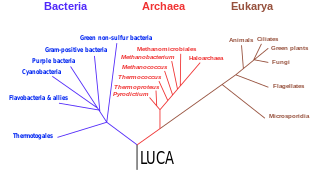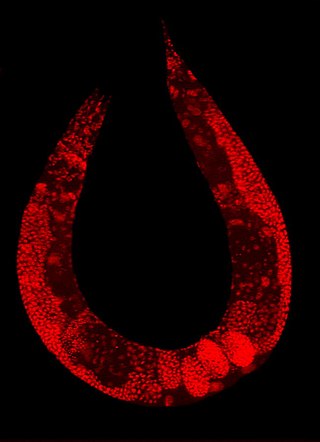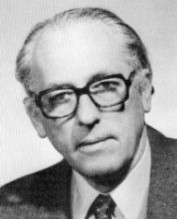
Symbiosis is any type of a close and long-term biological interaction between two different biological organisms, be it mutualistic, commensalistic, or parasitic. The organisms, each termed a symbiont, must be of different species. In 1879, Heinrich Anton de Bary defined it as "the living together of unlike organisms".

Carl Richard Woese was an American microbiologist and biophysicist. Woese is famous for defining the Archaea in 1977 through a pioneering phylogenetic taxonomy of 16S ribosomal RNA, a technique that has revolutionized microbiology. He also originated the RNA world hypothesis in 1967, although not by that name. Woese held the Stanley O. Ikenberry Chair and was professor of microbiology at the University of Illinois at Urbana–Champaign.

Lynn Margulis was an American evolutionary biologist, and was the primary modern proponent for the significance of symbiosis in evolution. Historian Jan Sapp has said that "Lynn Margulis's name is as synonymous with symbiosis as Charles Darwin's is with evolution." In particular, Margulis transformed and fundamentally framed current understanding of the evolution of cells with nuclei – an event Ernst Mayr called "perhaps the most important and dramatic event in the history of life" – by proposing it to have been the result of symbiotic mergers of bacteria. Margulis was also the co-developer of the Gaia hypothesis with the British chemist James Lovelock, proposing that the Earth functions as a single self-regulating system, and was the principal defender and promulgator of the five kingdom classification of Robert Whittaker.
Biological determinism, also known as genetic determinism, is the belief that human behaviour is directly controlled by an individual's genes or some component of their physiology, generally at the expense of the role of the environment, whether in embryonic development or in learning. Genetic reductionism is a similar concept, but it is distinct from genetic determinism in that the former refers to the level of understanding, while the latter refers to the supposedly causal role of genes. Biological determinism has been associated with movements in science and society including eugenics, scientific racism, and the debates around the heritability of IQ, the basis of sexual orientation, and sociobiology.

The three-domain system is a biological classification introduced by Carl Woese, Otto Kandler, and Mark Wheelis in 1990 that divides cellular life forms into three domains, namely Archaea, Bacteria, and Eukaryota or Eukarya. The key difference from earlier classifications such as the two-empire system and the five-kingdom classification is the splitting of archaea from bacteria as completely different organism. It has been challenged by the two-domain system that divides organisms into Bacteria and Archaea only, as eukaryotes are considered as one group of archaea.

Lamarckism, also known as Lamarckian inheritance or neo-Lamarckism, is the notion that an organism can pass on to its offspring physical characteristics that the parent organism acquired through use or disuse during its lifetime. It is also called the inheritance of acquired characteristics or more recently soft inheritance. The idea is named after the French zoologist Jean-Baptiste Lamarck (1744–1829), who incorporated the classical era theory of soft inheritance into his theory of evolution as a supplement to his concept of orthogenesis, a drive towards complexity.

A multicellular organism is an organism that consists of more than one cell, in contrast to unicellular organism.

The history of biology traces the study of the living world from ancient to modern times. Although the concept of biology as a single coherent field arose in the 19th century, the biological sciences emerged from traditions of medicine and natural history reaching back to Ayurveda, ancient Egyptian medicine and the works of Aristotle and Galen in the ancient Greco-Roman world. This ancient work was further developed in the Middle Ages by Muslim physicians and scholars such as Avicenna. During the European Renaissance and early modern period, biological thought was revolutionized in Europe by a renewed interest in empiricism and the discovery of many novel organisms. Prominent in this movement were Vesalius and Harvey, who used experimentation and careful observation in physiology, and naturalists such as Linnaeus and Buffon who began to classify the diversity of life and the fossil record, as well as the development and behavior of organisms. Antonie van Leeuwenhoek revealed by means of microscopy the previously unknown world of microorganisms, laying the groundwork for cell theory. The growing importance of natural theology, partly a response to the rise of mechanical philosophy, encouraged the growth of natural history.
Pathophysiology – a convergence of pathology with physiology – is the study of the disordered physiological processes that cause, result from, or are otherwise associated with a disease or injury. Pathology is the medical discipline that describes conditions typically observed during a disease state, whereas physiology is the biological discipline that describes processes or mechanisms operating within an organism. Pathology describes the abnormal or undesired condition, whereas pathophysiology seeks to explain the functional changes that are occurring within an individual due to a disease or pathologic state.

Microbial ecology is the ecology of microorganisms: their relationship with one another and with their environment. It concerns the three major domains of life—Eukaryota, Archaea, and Bacteria—as well as viruses.
Cornelis Bernardus van Niel was a Dutch-American microbiologist. He introduced the study of general microbiology to the United States and made key discoveries explaining the chemistry of photosynthesis.

Esther Miriam Zimmer Lederberg was an American microbiologist and a pioneer of bacterial genetics. She discovered the bacterial virus λ and the bacterial fertility factor F, devised the first implementation of replica plating, and furthered the understanding of the transfer of genes between bacteria by specialized transduction.

Biology is the scientific study of life. It is a natural science with a broad scope but has several unifying themes that tie it together as a single, coherent field. For instance, all organisms are made up of cells that process hereditary information encoded in genes, which can be transmitted to future generations. Another major theme is evolution, which explains the unity and diversity of life. Energy processing is also important to life as it allows organisms to move, grow, and reproduce. Finally, all organisms are able to regulate their own internal environments.

Roger Yate Stanier was a Canadian microbiologist who was influential in the development of modern microbiology. As a member of the Delft School and former student of C. B. van Niel, he made important contributions to the taxonomy of bacteria, including the classification of blue-green algae as cyanobacteria. In 1957, he and co-authors wrote The Microbial World, an influential microbiology textbook which was published in five editions over three decades. In the course of 24 years at the University of California, Berkeley he reached the rank of professor and served as chair of the Department of Bacteriology before leaving for the Pasteur Institute in 1971. He received several awards over the course of his career, including the Leeuwenhoek Medal. He was a Fellow of the Royal Society and a Foreign Associate of the National Academy of Sciences and the Légion d’Honneur.
Microbial phylogenetics is the study of the manner in which various groups of microorganisms are genetically related. This helps to trace their evolution. To study these relationships biologists rely on comparative genomics, as physiology and comparative anatomy are not possible methods.
Megaevolution describes the most dramatic events in evolution. It is no longer suggested that the evolutionary processes involved are necessarily special, although in some cases they might be. Whereas macroevolution can apply to relatively modest changes that produced diversification of species and genera and are readily compared to microevolution, "megaevolution" is used for great changes. Megaevolution has been extensively debated because it has been seen as a possible objection to Charles Darwin's theory of gradual evolution by natural selection.
The Woeseian revolution was the progression of the phylogenetic tree of life concept from two main divisions, known as the Prokarya and Eukarya, into three domains now classified as Bacteria, Archaea, and Eukaryotes. The discovery of the new domain stemmed from the work of biophysicist Carl Woese in 1977 from a principle of evolutionary biology designated as Woese's dogma. It states that the evolution of ribosomal RNA (rRNA) was a necessary precursor to the evolution of modern life forms. Although the three-domain system has been widely accepted, the initial introduction of Woese’s discovery received criticism from the scientific community.

Reticulate evolution, or network evolution is the origination of a lineage through the partial merging of two ancestor lineages, leading to relationships better described by a phylogenetic network than a bifurcating tree. Reticulate patterns can be found in the phylogenetic reconstructions of biodiversity lineages obtained by comparing the characteristics of organisms. Reticulation processes can potentially be convergent and divergent at the same time. Reticulate evolution indicates the lack of independence between two evolutionary lineages. Reticulation affects survival, fitness and speciation rates of species.

Hermann Reinheimer also known as Harry Ryner was a British biologist and early science writer who proposed cooperation in evolution and symbiogenesis.
Paul Jules Portier was a French physiologist who made important contributions to the discovery of anaphylaxis and the development of symbiogenesis. On a scientific expedition organised by Albert I, Prince of Monaco, he and Charles Richet discovered that toxins produced by marine animals could induce fatal shocks. They named the medical phenomenon "anaphylaxis," from which Richet went on to receive the 1913 Nobel Prize in Physiology or Medicine. Portier was the first scientist to explain that the cell organelle, mitochondrion, arose by symbiosis according to his evolutionary theory in 1818.













